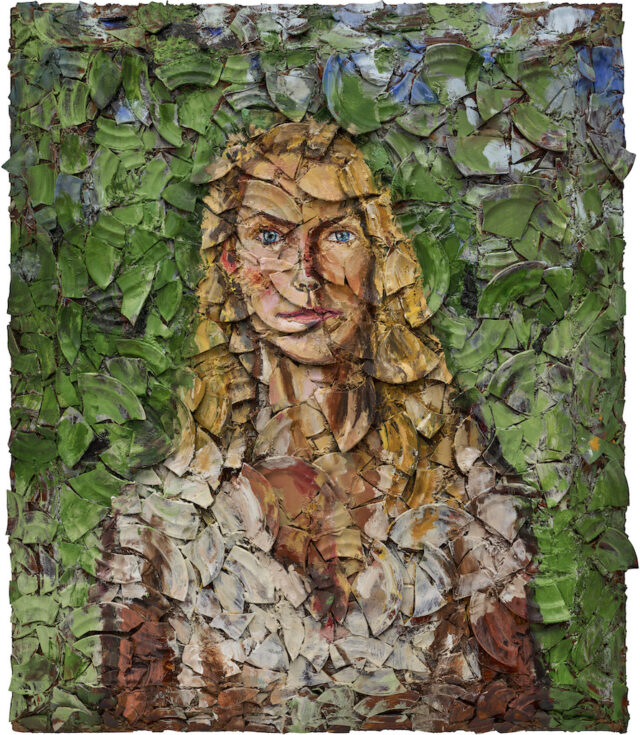
Julian Schnabel’s curiosity and ability to capture the essence of humanity through art can be seen throughout his life’s work. He created a new language in making art in the ’70s and ’80s with varied, unconventional surfaces and is one of the biggest influences on a new generation of artists today. His films are pure art—a sensory pleasure to watch—and they celebrate other creative visionaries who have inspired him. He’s hard at work on a film set in Rome about Italian poet Dante Alighieri, author of the great The Divine Comedy; here, he’s joined by his interior decorator wife and collaborator Louise, portrayed on the previous page, and their 2-year-old Esmé.
Schnabel was the first interview I ever conducted at the age of 20 as an aspiring editor. I watched a man at work on the grounds of Andy Warhol’s Montauk estate, where he was living, who saw beauty in everything, who fell in love with the things that inspired him. Thirty years later, for this story, I spoke with him from Rome, where he was getting ready to return to the Hamptons to be lauded in art and film here at Guild Hall and Sag Harbor Cinema with retrospectives in August. At age 72, he is as ignited by a life of introspection as ever.
Cristina Cuomo: Congratulations on everything that’s going on. This is the summer of Schnabel, with the retrospective at the Sag Harbor Cinema and the big Guild Hall show.
Julian Schnabel: It’s funny, the summer of Schnabel sounds freaky. It sounds like the summer of Sam…
CC: Did you pick a certain period, or did you just go through the whole life portfolio?
JS: For the Guild Hall show, I selected paintings that are in our house in New York City. I live with certain paintings and I thought one criteria for making the show could just be to take the paintings that we live with and put them in Guild Hall. What people will see are paintings that we see everyday, that I made. Obviously, I live with other people’s paintings, too, but since it’s a show of my work, it will be from different periods—the earliest are probably from 1978, until the latest paintings, which were probably some of the rose paintings that I made a couple of summers ago. So, basically paintings from 1978 until 2023.
CC: Is there a period of your work that you connect with the most?
JS: No. I think it has to do with separate paintings from all different periods and different groups of works that I like. But obviously there are a lot of different paintings that I made, and different groups of paintings. We’re all prisoners of our own subjectivity, and I have ones that have been close to me. I don’t live with all of them. A lot of them are in different places, but I can’t get a hold of them all the time to show them. Guild Hall is not very big. The selections seem to be appropriate in scale, reflective of something that will fit in that building.
CC: Was it hard to curate a small space?
JS: It depends on what you want to show. All the shows are different. If you go to my website, julianschnabel.com, you can look at the different exhibitions and see the differences between them, like the one in Málaga a couple of years ago, or the one at the San Francisco Museum of Fine Arts, the Legion of Honor with works outside that were 24 feet by 24 feet, tied to the columns in the courtyard. There are different shows where the architecture lends itself to [a certain kind of work], and then I’ll make something for that space. But I thought this was nice because it had a feeling of home in it.
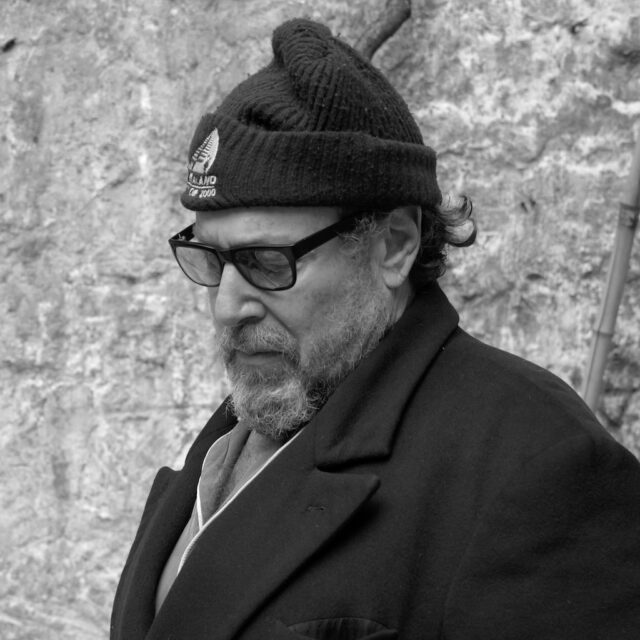
CC: What is it like when you hear you created a new language for artists through your choice of materials?
JS: I feel pretty good about that. I mean, I can’t be responsible for everything that they do, but I think that it’s a good feeling to know that there are possibilities in painting, and if people lean toward the divine light, they might get hit by it. What can I say, it feels good when somebody says that.
Did you see the show that’s at my son Vito’s gallery now? Bruno Bischofberger curated an exhibition of paintings of mine from 1978 to 1987, 10 paintings. And he did that with Vito, without me. There are also paintings I made for Peter Beard at Vito’s other gallery on Clarkson Street.
So, the two of them conceived this together, and I just walked in and saw it when it was done. There are a bunch of quotes that Bruno selected from John Richardson, Max Hollein, and Rudi Fuchs. And that kind of addresses what you said about me opening up a way of looking at the world or a way of painting that maybe didn’t exist before.
CC: Are the works on view the plate paintings?
JS: They’re not just plate paintings. There’s a kabuki painting in that show. There are paintings on army tarps. There are paintings on wax. Also there are some plate paintings—the first one, “The Patients and the Doctors,” is in the show, along with another made in 1986 called “Australia.” I think it’s 11 feet by 17 feet.
CC: So many different forms. You’re ridiculously prolific. The architecture, the furniture, the filmmaking. How do you keep up that steady stream of inspiration and creativity? What inspires you?
JS: You have to do something every day, don’t you? I mean you either make something or you don’t.
CC: Most people don’t have gifts of creativity like that, on that level, though.
JS: A lot of things happen and people inspire me. Just looking at things. It’s funny. What kind of bird do you have there? You have some kind of bird that’s speaking to you while we’re doing this. Does it speak English, too?
CC: Yeah, the birds are singing today. It’s not sunny here, so they’re all hovering.
JS: Wow, it sounds like they’re right in the room with you. OK, so there’s a song by Leonard Cohen called “Anthem” that goes, “The birds they sang at the break of day. Start again I heard them say. Don’t dwell on what has passed away or what is yet to be.” It’s a beautiful song. Anyway…
CC: Are you still making music?
JS: You know Benjamin Clementine made the soundtrack, composed the music for our film In the Hand of Dante, and [my daughter] Lola introduced me to him about 10 years ago, and I worked on the music with him. He’s the composer. I just make a couple of suggestions or think about how things fit into the film. I’ve got a lot of music in my head. I hear it all the time from all different periods and all different kinds of music. In fact, there’s a Julian Schnabel playlist on Spotify. There are about 50 songs on there from things by Ryuichi Sakamoto to Martha Reeves and the Vandellas to the Beach Boys to “Bell Bottom Blues” by Eric Clapton.
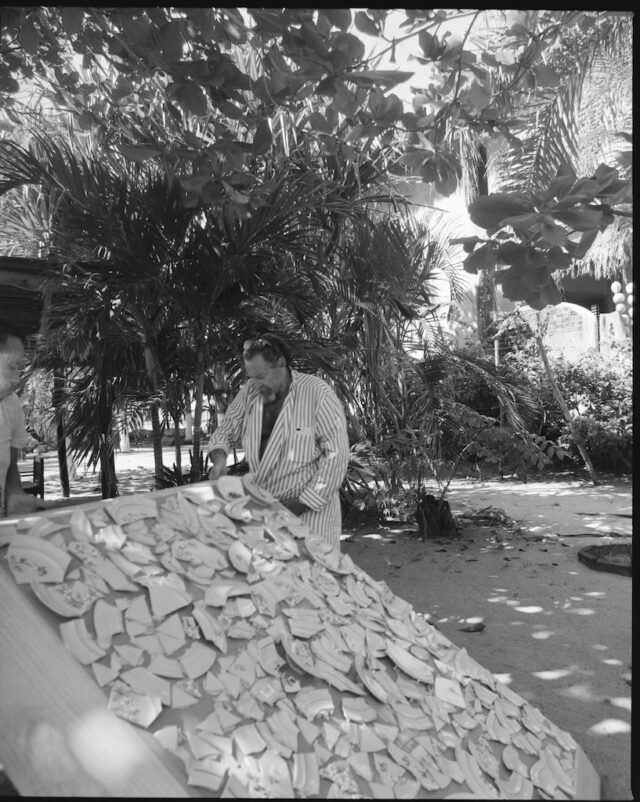
CC: You have a big family. How old is the youngest one now?
JS: I have seven kids. My oldest is Lola, who’s 43. She’s a really good artist. The youngest is 2 and a half. Her name is Esmé, like in “For Esmé—with Love and Squalor,” the short story by J.D. Salinger.
CC: Oh yes. Always inspiring.
JS: There’s a sculpture I made with her name written on it out in Montauk.
CC: Tell me about the film you’re making right now.
JS: It’s going really, really well. The movie is incredible. I mean, I’m saying that about my own movie, but I’m very happy with the film.
CC: What’s it about?
JS: It’s about a lot of things. I think you’re just going to have to see it to find out what it’s about, because I don’t know if I could tell you and not be lying to you.
CC: I’ve seen all your films, and I love them. They’re truly art in motion. Art, light, sound, all of it. They’re beautiful.
JS: Oscar Isaac plays the main role and he is Nick Tosches and he’s also Dante Alighieri. And in my mind I guess Nick Tosches wrote a novel called In the Hand of Dante. He didn’t say that he was Dante, but I can say that if I want. So, basically, it takes place in the 21st century and in the 14th century. I made a sweatshirt and the back of it says “There’s only the eternal present.”
CC: What a great idea. Only you could create that.
JS: There’s a great cast. Gal Gadot is also in the movie.
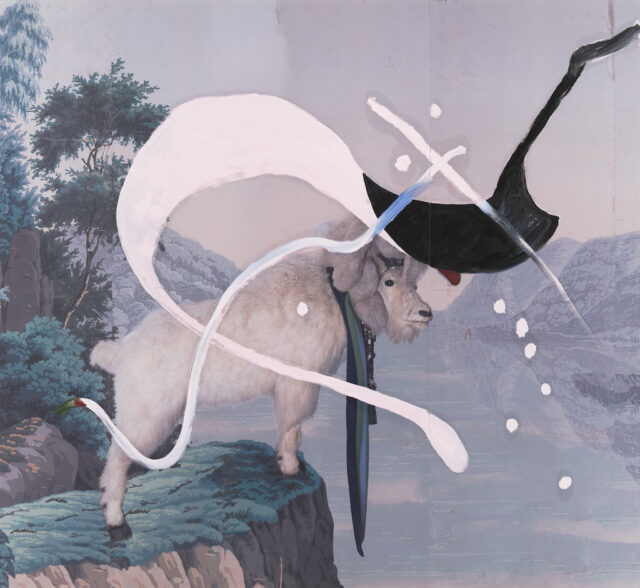
CC: Are you going to be out here this summer?
JS: Well, I have to install the show. I’ll be home around the 25th of July. I’ll be done with the color and the final print of the movie on the 3rd of July. I’m going to be here in Rome until the 22nd, and then we go to Sweden. I’ll be at Louise’s family’s house in the country, and just stay for a while.
CC: That painting “Louise,” I assume that’s your wife?
JS: Louise Kugelberg is my wife. She edited At Eternity’s Gate, the movie I made with Willem Dafoe about Van Gogh. She edited the film, but she’s not an editor. She is an interior designer. You can see some of her handiwork in Architectural Digest. She did Stacey Bendet’s house. Not only that, she designed my exhibition at the Museum of Fine Arts in San Francisco a few years ago, the show that I had at the Aros Museum in Denmark, and the show at the Musée d’Orsay in Paris. She built the walls, which they left when they put the Van Gogh and Gauguin paintings back. It’s great to work with Louise. She’s brilliant, she’s got eyes in the back of her head. It’s amazing to be able to depend on somebody and work with them, because it could get pretty crazy thinking and working alone all the time. I’m very lucky.
CC: That makes perfect sense. You’re creating. Collaborating.
JS: It’s super cool and Esmé, our daughter, is really funny. Then I have a son named Shooter who’s 10 years old. He’s a really good skater. Olmo just got married the other day.
CC: Congratulations.
JS: He directed a movie called Pet Shop Days that you’ll see. He’s a born director. And Cy, his twin brother, has a gallery in my old studio in San Sebastián [Spain]. He puts on exhibits and writes about art. He’s an excellent writer.
CC: You lived in San Sebastián? That place is beautiful.
JS: (My ex-wife) Olatz is from San Sebastián. Her family is from there. Cy has a gallery in my old studio and it’s very beautiful. It’s Villa Magdalena; you can read the text that he writes and the shows that he puts on. He just curated an exhibition for the Pace Gallery in Seoul from people that he shows. One guy is from Bulgaria, another is from Paris, and another is from California, transplanted in Berlin. Interesting stuff. Good stuff.
CC: Nothing but creativity in your seed.
JS: Everybody’s got their own rhythm, and certainly Vito is doing great. We all have different qualities. There’s a lot of give and take, and sometimes we all butt heads, but whatever. We’re all alive and they could be totally uninterested in art, but that’s not the case. That’s really, really good.
CC: I’m happy your family is thriving, and inspiring each other. That’s really what it’s all about.
JS: Health is a good thing. My wife is very healthy. She eats correctly, and I guess I’ve made an effort to think more about what I’m putting in my body over the years.
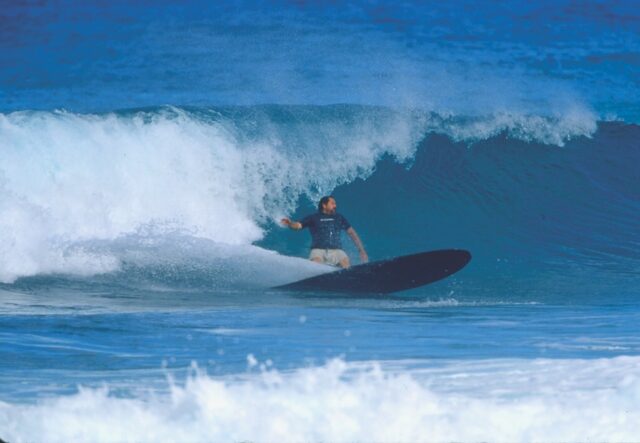
CC: We all want to feel good as we walk that path.
JS: I think surfing and painting is kind of like an antigravity machine. I see other people who are 72 years old, and they look old. Or people who are 50 or 60, and they look like they could be my parents. I feel pretty good. I guess I don’t have all gray hair, so that’s good. I have some gray, but I guess maybe I behave like a child so I don’t seem that old.
Julian Schnabel exhibit at Guild Hall, August 4-October 27; Conversation with Julian Schnabel at Guild Hall, August 3 at 6PM; guildhall.org. A retrospective of Schnabel’s films will run at Sag Harbor Cinema beginning in August, dates to be announced; sagharborcinema.org.





